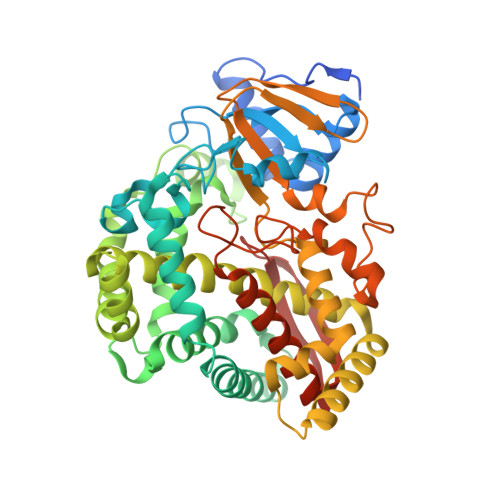Structural insights into the evolutionary paths of oxylipin biosynthetic enzymes.
Lee, D.S., Nioche, P., Hamberg, M., Raman, C.S.(2008) Nature 455: 363-368
- PubMed: 18716621
- DOI: https://doi.org/10.1038/nature07307
- Primary Citation of Related Structures:
2RCH, 2RCL, 2RCM, 3CLI, 3DSI, 3DSJ, 3DSK - PubMed Abstract:
The oxylipin pathway generates not only prostaglandin-like jasmonates but also green leaf volatiles (GLVs), which confer characteristic aromas to fruits and vegetables. Although allene oxide synthase (AOS) and hydroperoxide lyase are atypical cytochrome P450 family members involved in the synthesis of jasmonates and GLVs, respectively, it is unknown how these enzymes rearrange their hydroperoxide substrates into different products. Here we present the crystal structures of Arabidopsis thaliana AOS, free and in complex with substrate or intermediate analogues. The structures reveal an unusual active site poised to control the reactivity of an epoxyallylic radical and its cation by means of interactions with an aromatic pi-system. Replacing the amino acid involved in these steps by a non-polar residue markedly reduces AOS activity and, unexpectedly, is both necessary and sufficient for converting AOS into a GLV biosynthetic enzyme. Furthermore, by combining our structural data with bioinformatic and biochemical analyses, we have discovered previously unknown hydroperoxide lyase in plant growth-promoting rhizobacteria, AOS in coral, and epoxyalcohol synthase in amphioxus. These results indicate that oxylipin biosynthetic genes were present in the last common ancestor of plants and animals, but were subsequently lost in all metazoan lineages except Placozoa, Cnidaria and Cephalochordata.
Organizational Affiliation:
Department of Biochemistry and Molecular Biology, University of Texas Medical School, Houston, Texas 77030, USA.

















